Watch back all our PMO Conference sessions
PMO Conference 2022 \\ Mastering Lean Portfolio Management – Jon Ward
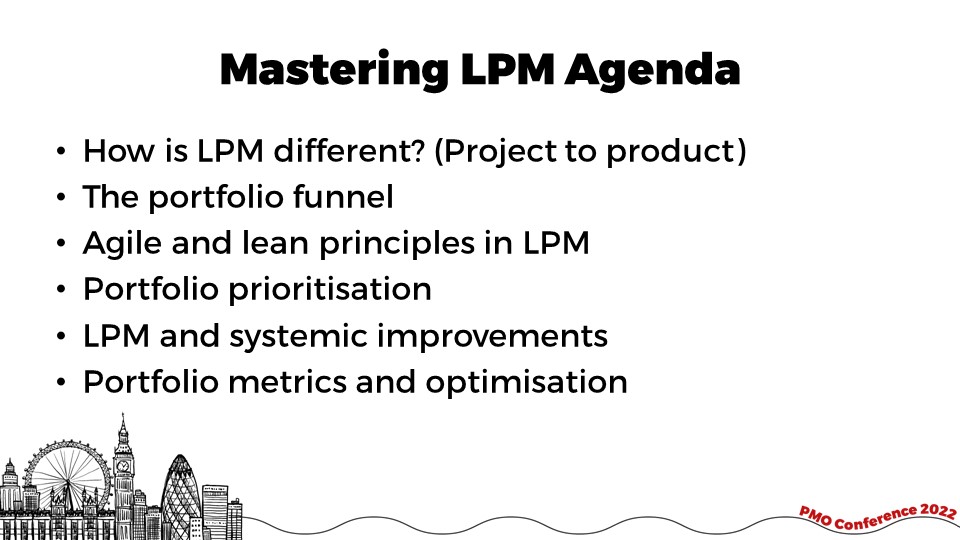
Lean Portfolio Management seeks to maximise the business value created from inward investments and as such is an essential part of the PMO toolkit in enterprises using agile delivery methods.
This session will outline how Lean Portfolio Management uses Lean and systems thinking to provide new approaches for; strategy execution, funding of investments, portfolio operations, and governance.
It will give an overview of how Lean Portfolio Management supports DevOps approaches by breaking initiatives down into smaller deliverables to increase Flow and create delivery efficiency.
The session will include an introduction to Lean Portfolio Management theory illustrated with practical examples from implementing Lean Portfolio Management across a 6000 person technology team in a global financial institution with a budget in excess of £1 billion.
Session Recording
Slidedeck
Session Notes
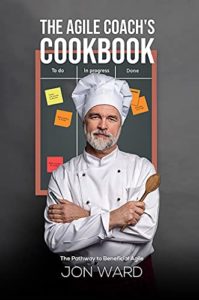 Jon Ward is an Agile coach, more suited to jeans and t-shirt than a suit, having started his career as a project manager he has been involved in Agile since 2007, working as a SAFe Program Consultant (SPC) in a scaled agile framework. Jon has written 2 books, The Agile Coaches Cookbook and Agile Lineout and is currently responsible for Lean transformation in a tier 1 bank with 6,000 people and 650 teams and a budget of £1.2B
Jon Ward is an Agile coach, more suited to jeans and t-shirt than a suit, having started his career as a project manager he has been involved in Agile since 2007, working as a SAFe Program Consultant (SPC) in a scaled agile framework. Jon has written 2 books, The Agile Coaches Cookbook and Agile Lineout and is currently responsible for Lean transformation in a tier 1 bank with 6,000 people and 650 teams and a budget of £1.2B
The agenda starts with asking “How is Lean Portfolio Management (LPM) different?”, LPM is about systemic improvement, and was birthed by Edward Deming and the quality improvement movement, but how do you qualify improvement?
A project is clearly defined as a temporary undertaking, its disposable and when we get a team together they assemble around the delivery, become experts and move off. This is one of the paradigms that Lean is set to change by moving from project to product.
Putting in more context, does anyone not believe that change is permanent? Project to product is about a means of production i.e. delivering a production line. In PMO that means how to control the production line, it is a tube with no start and end, no stage gate processes to go through – a continuous process.
Most people have heard of the Tuckman model about team effectiveness (Forming, Storming, Norming, Performing, Adjourning), in Agile there are long lived teams, focussed on Governance; Testing and Agile programmes and workstreams with a Kanban structure rolled into the overall programme structure. We keep teams together in Agile to avoid drop, to engineer the portfolio to make effective use of resource, skillset and deliver customer value.
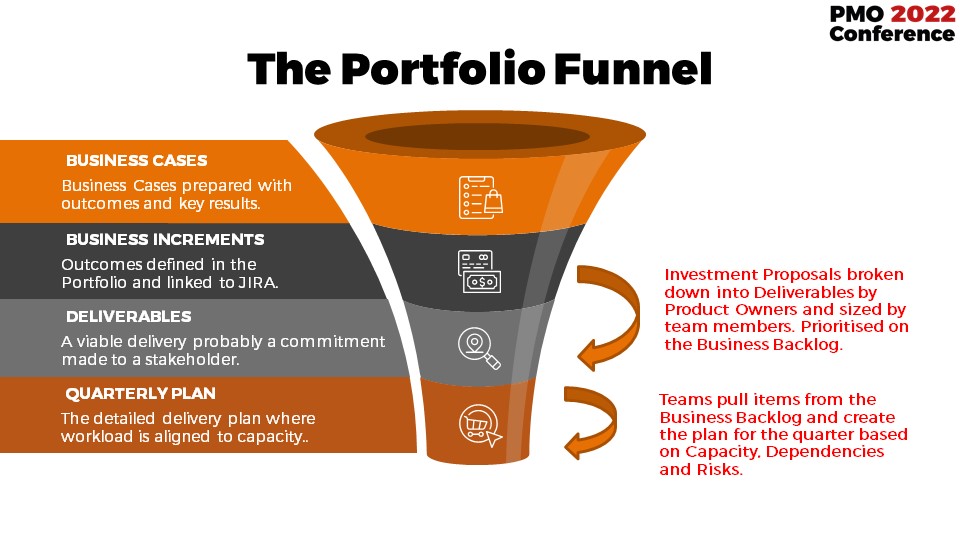
 When looking at inputs into the Portfolio, we start with strategy which begats projects, these need to be aligned to strategic change and constantly responding to regulation or market change (fixed dates), then there is continuous improvement.
When looking at inputs into the Portfolio, we start with strategy which begats projects, these need to be aligned to strategic change and constantly responding to regulation or market change (fixed dates), then there is continuous improvement.
Continuous Improvement
How do requests for work get into the pipeline, and how does the portfolio get balanced? Jon talked about a role where he had the job to find out why a company wasn’t delivering strategic change. Projects were described as A = Strategic B = Market Change; C= Small friendly change (continuous improvement). It was clear very quickly that C was prevalent, and that will ultimately kill the business.
Agile delivers incrementally ensuring value to the customer as early as possible. The demand management funnel has the business cases going in first, then business increments (this allows you to flex and give a (MVP) minimum viable product. When defining increment, you must look at the end-to-end solution and it will depend on the context (of the organisation etc).
With quarterly planning we are not allocating budget unlike with annual planning. It gives some extra flexibility and generally the deliverables are planning on a quarterly basis too.
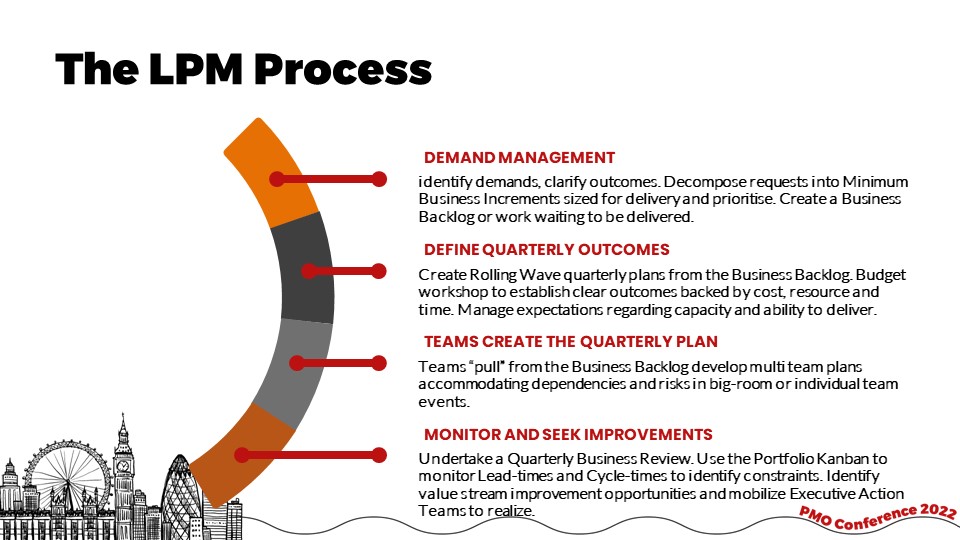
Annual Plan
To manage this instead of an annual plan, they do quarterly planning, concentrating delivery effort in 16 weeks. There are pots of money in place, but what is important for the business is to deliver value, respond to business needs. Further breaking down work into epics or features; then stories produced in sprints of 2 weeks, the detail of planning for quarterly is at Epic level.
Agile is about using the brain of the team (10 people planning for example) to produce plan, not just one project manager which gives more buy-in and engagement, the teams then create their plan for quarter based on sponsor input and they see how they fit into the big picture which makes a huge difference in the LPM process teams.
Monitor and Seek Improvements
PMO likes stability and the PMO can look at governance in terms of a continually improving cycles, where the PMO monitors and look at impact on delivery cycles. LPM delivers output 40% quicker than Waterfall. (The State of Agile Report 2021)
Budgets and Estimates
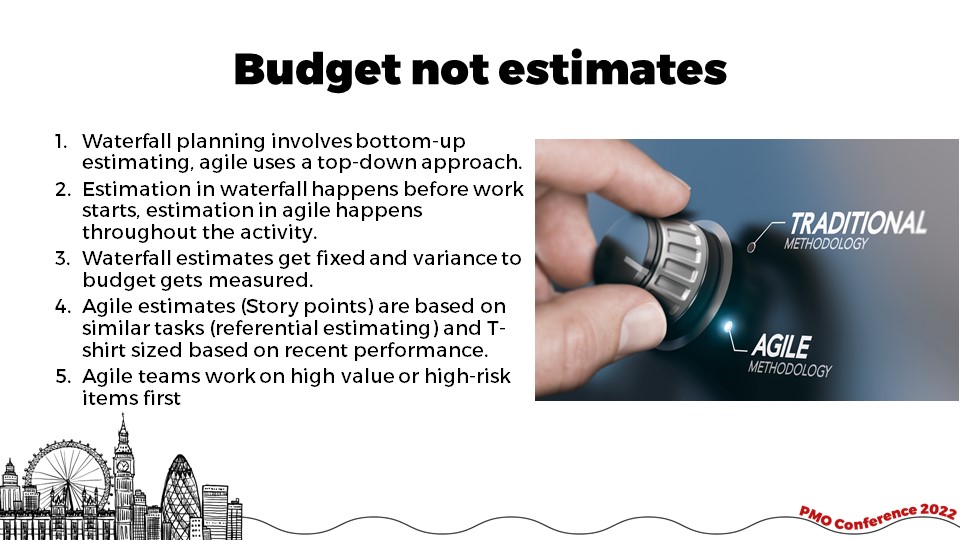
LPM uses budgets not estimates, every product that you buy has a design to cost budget i.e. BMW, they know the budget for a family and for a family saloon and will design accordingly; if designing for an oligarch a different cost budget will be applied. In Agile you will keep going until you run out of money, the backlog is a shopping list of stuff you are not working on which is checked quarterly for value to see if it needs to be done, ensuring you work on the important bits (high value items) of the business case.
Agile does however do some estimates.
Agile does an estimate for capacity planning every 2 weeks, but the estimate happens for waterfall before the project starts, which means that waterfall budgets are fixed and focus on variance, needless to say Accountants don’t like Agile budgeting! Agile estimates story points and t-shirt sized based on recent performance, balancing workload with capacity which makes the estimate more accurate. A Product Owner prioritises work based on high risk first (MOSCOW)
Capacity
Capacity is crucial for Agile, what happens if a dam reaches capacity, you get a flood with real damage, it’s basically the same with a team, you will find that if you overload a team, people will leave or move on, which will cause delivery of value to slow down. When you have a lot of context switching, we lose effectiveness (cognitive load) and it is proven that overload reduces productivity by 20%.
So how do we improve the productivity of the teams?
Something called ‘pull’. The team continue to work on the backlog until the team reaches capacity. From a portfolio view, we’re looking at the progress to see whether the backlog is going down. This is monitored at deliverable or epic level (not story level, which is too granular) and the sprints provide start and end dates, individuals can pull work when they have capacity, and that work links directly to the Agile Manifesto, to get customer satisfaction.
Prioritisation
Working in minimum business increment (MBI), means that you start to get feedback as soon as you deliver to the customer. For activities with an unclear ROI – you can estimate delay costs and use lead time (time between initiation and completion of a production process – or time that a work item is identified) to prioritise rather than HIPPO prioritisation (highest paid persons opinion).
Teams
LPM is a team sport, defensive plays improve efficiency of the team, and helps us to understand what is slowing us down, for example a hand-off would be quicker to have all teams in same locations, using a Kanban board to show blockers. He talks in the session about a currentl example he’s working on.
Blockers are one area that the PMO could help support – in removing the blockers.
In looking at the project delivery value stream, think about your delivery process, most PMO’s have a process to manage projects. A PMO should be able to see where the blockers are in the delivery process.
With the production line concept, we ensure that people learn and work together. We must prioritise the value stream, ensure continuous flow (metrics: Flow Velocity, Flow Time, Flow Efficiency) or manage what is left on backlog. Maybe more has been added with a higher priority, but backlog process ensures that we spend money to get the best value, being sure to cleanse the backlog (“backlog cleansing”) after items have been left too long.
LPM uses basic Lean principles to create flow and establish pull which all comes from Total Productive Maintenance (TPM) which is the main pillar of the Toyota Development System (TPS) developed in 1960/70’s.
Adaptive Governance
Adaptive Governance is just what it sounds like,for example there is a monthly steering committee i.e. a meeting is in the diary, but if the project is green then project steer-co is dropped and attention is focused on the needs of the business and team.
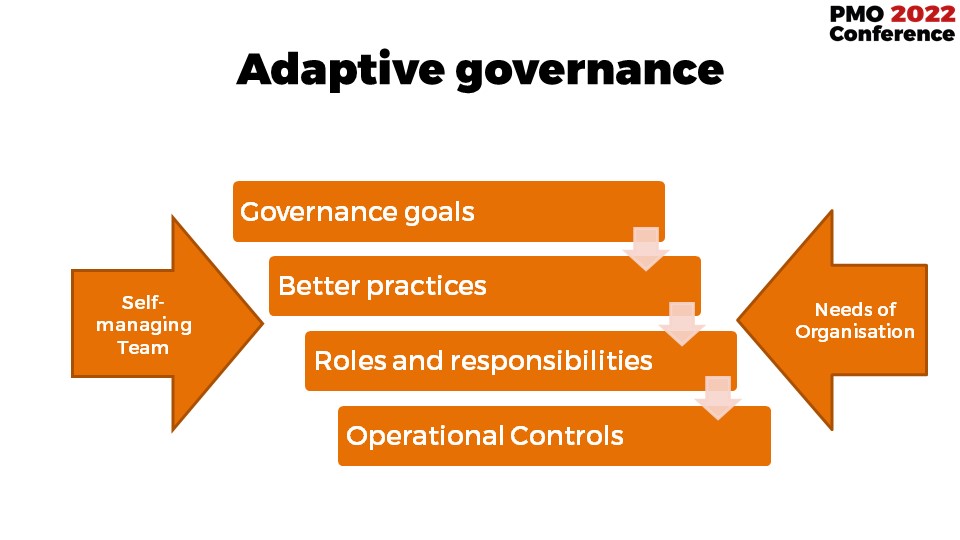
In summary, Lean and Agile prioritises work based on value, constantly looking at the business case. Planning is based on workload and capacity, with an optimal workload enabling the team to go to backlog for more work if required. This leads to efficiency from the team, from delivery and for the organisation.
